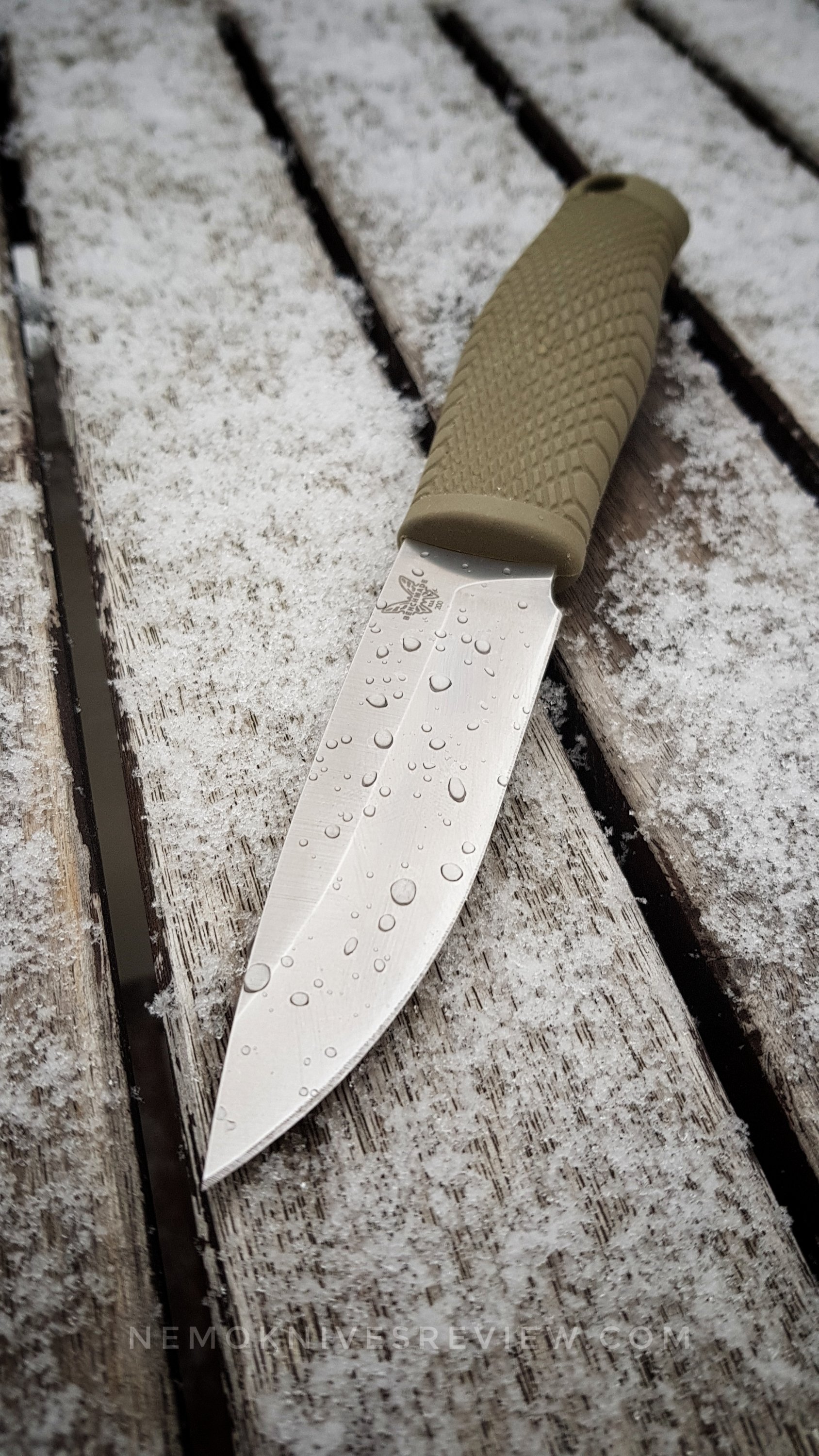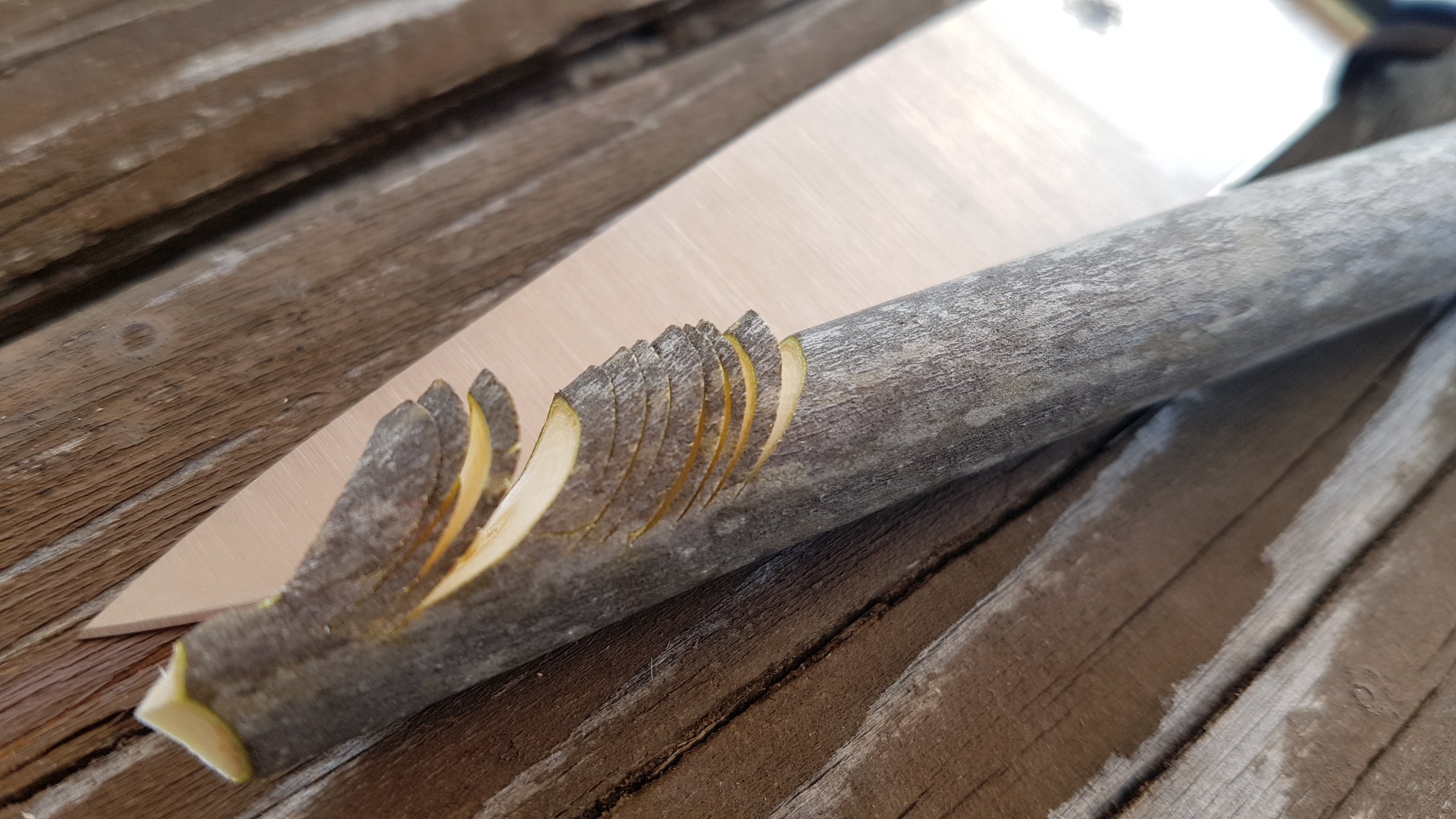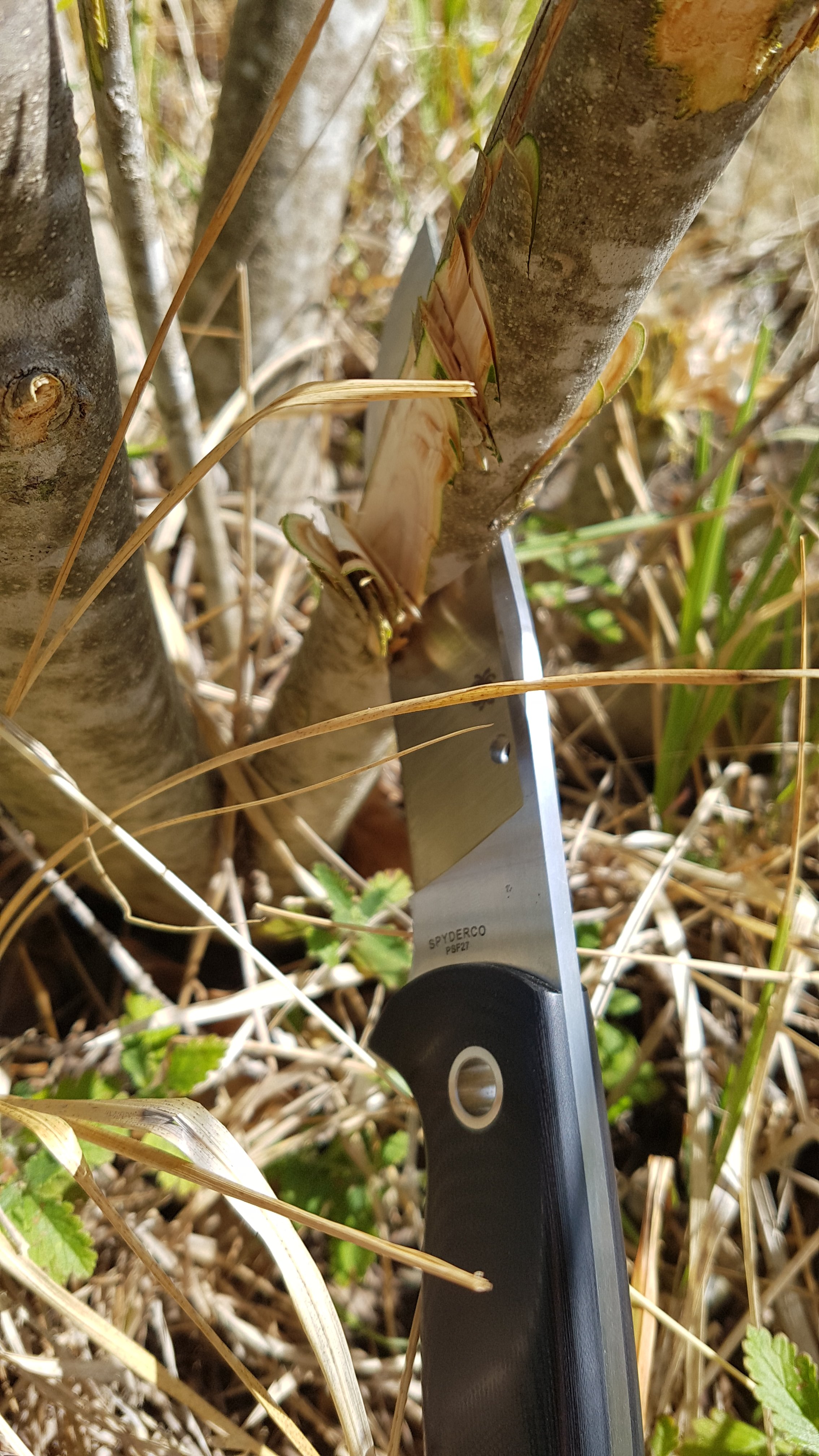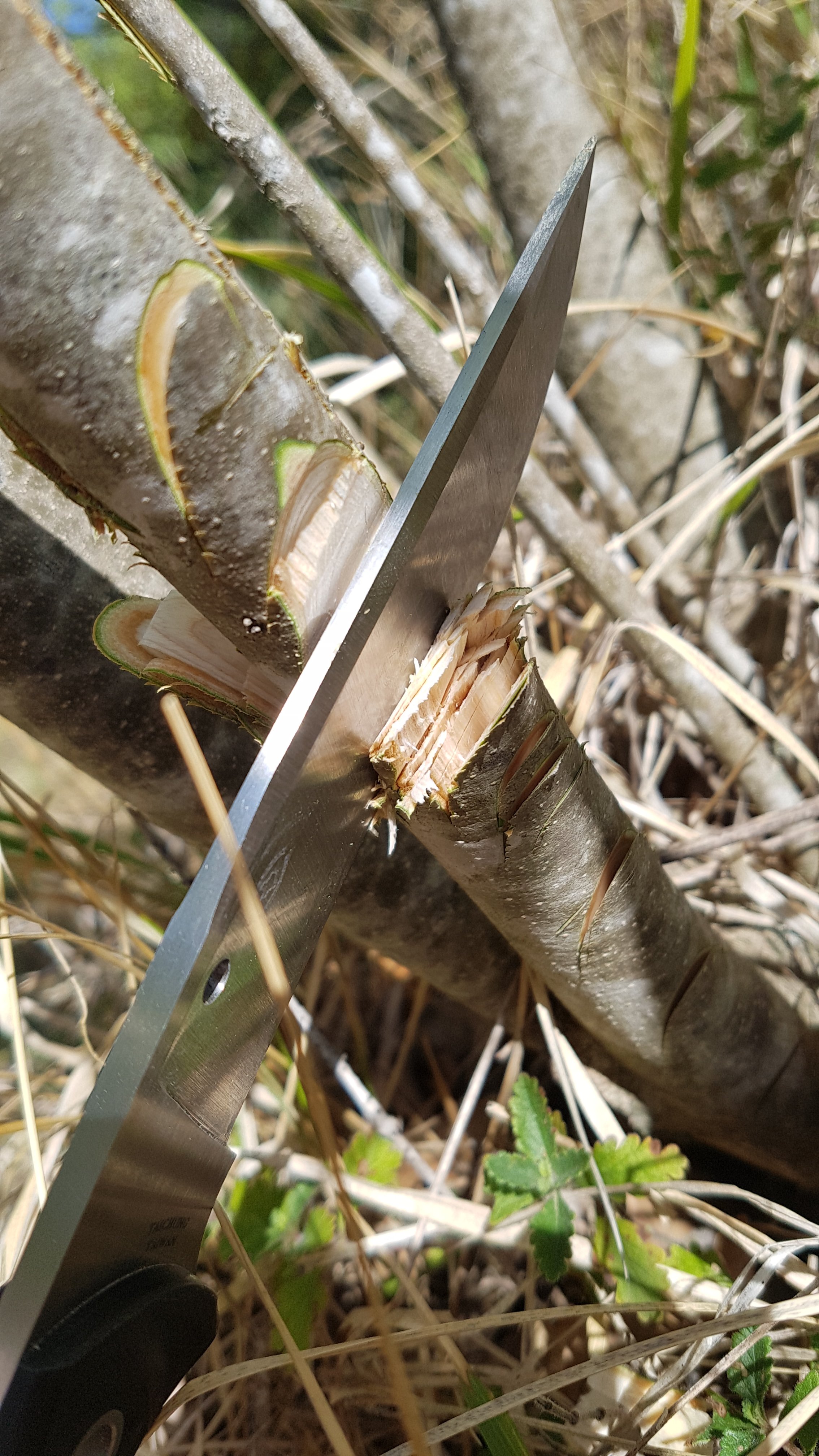
Ed Schempp is one of my favorite designer. As I have always written, the spirit of a maker oozes from his knives. Ed is a true gentleman, a cever inventor and a gifted bladesmith and all his designs got something pure and radical. His Khukuri is a perfect example.

Look at it closed. It looks so classical. Nothing particular but beware of dormant waters.

Once open you got a tool which makes love with your hand. This knife is made for your palm and finger and to be held and use and…
Well the knife is screaming to be used. It is stunning. The handle is thin and does not feel boxy. The generous choil welcomes you index.
Then you notice the angle the blade is doing with handle. This natural angle is the signature of Kukri knives used in Nepal by the famous Gurkhas. It is also a signature of Ed Schempp’s knives. Especially short knives and folders. I have seen Ed’s custom Khukuri with beautiful damascus steel using Spyderco logo as pattern…
To quote Sal Glesser: “I can do anything”, Ed Schempp, will push the envelope, often just to see if he can. I did a “hammer” in at Ed’s house. Just a bunch of knife afi’s with great skill working on a globe. But no hammers. Ed designed and built a series of miniature rolling mills so we can produce mosaic damascus pieces, each with an assignment. Ed’s my “go to” guy for Ethnic series knives. Take a design hundreds, or even thousands of year old, capture the purpose and function and re-create that in a modern folder. He studies the design, the history, function and purpose before beginning. Those of you that have studied and used Ed’s designs know what I’m talking about. True original classics, each and every one.”
What can I say more ?

Even in Icepick grip the little folder is pure ergonomy. The full flat ground blade is generous in belly and recurve bringing very powerful cuts. No need for any jimping on the spine or the handle, the knife is simply glued to your grasp.

Can you see the family’s blood, the Schempp’s touch ? The Tuff, the Khukuri, the Bowie and their long choil and angle ? Elegance and “beautility”. Oh, I dream of a Kukhuri Sprint Run because that design needs to be used again. An AEB-L version please ?
And a huge thank you to Geoffrey from Normandeep.fr who is the proud owner of my four last reviewed knives.
















 That handle is made in some kinf of thermorun… but it is rubberized Santoprene is a soft, non-hygroscopic elastomer which exhibits excellent surface appearance, a durable soft-touch feel, excellent colorability and excellent “processability”… made by Exxon.
That handle is made in some kinf of thermorun… but it is rubberized Santoprene is a soft, non-hygroscopic elastomer which exhibits excellent surface appearance, a durable soft-touch feel, excellent colorability and excellent “processability”… made by Exxon.
































 RIL of
RIL of 


























 It has all started when I wanted to review the Spyderco Gayle Bradley Junction. It’s a great design for an EDC fixed blade which can be used for everything. Easy to carry in its pancake constructed bolteron sheath. But the edge was just too thick for my own use.
It has all started when I wanted to review the Spyderco Gayle Bradley Junction. It’s a great design for an EDC fixed blade which can be used for everything. Easy to carry in its pancake constructed bolteron sheath. But the edge was just too thick for my own use.  To my knowledge, SPF27 is some kind of CPM D2 steel. A lot of carbon 1.5% and not a lot of chromium around 12%. Not the easiest on the stone as a semi stainless. It was not very soft under the diamonds compared to another blade in N690 HRC59 I got with me. And it was not really easy to remove the shoulder to create a gentle convex edge. Patience… In sharpening is important. And I often lack of it but I was able to improve it.
To my knowledge, SPF27 is some kind of CPM D2 steel. A lot of carbon 1.5% and not a lot of chromium around 12%. Not the easiest on the stone as a semi stainless. It was not very soft under the diamonds compared to another blade in N690 HRC59 I got with me. And it was not really easy to remove the shoulder to create a gentle convex edge. Patience… In sharpening is important. And I often lack of it but I was able to improve it.  Next some black stone mostly to remove the scratches.
Next some black stone mostly to remove the scratches.  And then the white ceramic to get a better finish and a razor steel.
And then the white ceramic to get a better finish and a razor steel.  You can notice the chamfered signature hole on the Junction. A première. The cuts were deeper. It was better! Much more enjoyable.
You can notice the chamfered signature hole on the Junction. A première. The cuts were deeper. It was better! Much more enjoyable.  But the spine was too sharp for my thumb and diamonds came handy to rounded the angles. It would never be a Sebenza spine….
But the spine was too sharp for my thumb and diamonds came handy to rounded the angles. It would never be a Sebenza spine….  Again the control during whittling was much much better. One should never be scared to round the edges for suiting your own needs.
Again the control during whittling was much much better. One should never be scared to round the edges for suiting your own needs.  The handle is very flat on that knife. It’s an attention for people who wish to stash their knife in a pocket or a backpack without leaving a print.
The handle is very flat on that knife. It’s an attention for people who wish to stash their knife in a pocket or a backpack without leaving a print.  But a flat knife is not the most comfortable in the palm of your hand… Especially when cutting hard things for a long time.
But a flat knife is not the most comfortable in the palm of your hand… Especially when cutting hard things for a long time.  I decided to make a quick comparison with the Spyderco Sprig which is a pleasure to use.
I decided to make a quick comparison with the Spyderco Sprig which is a pleasure to use.  You can notice how the Phil Wilson’s Sprig got a thicker handle. And it change everything when cutting hard things. Also Phil Wilson’s is all about performances. Its geometry is stellar.
You can notice how the Phil Wilson’s Sprig got a thicker handle. And it change everything when cutting hard things. Also Phil Wilson’s is all about performances. Its geometry is stellar.  It immediately cuts deep in wood without any real improvement needed….
It immediately cuts deep in wood without any real improvement needed….  But diamonds were there to be usef. 🙂
But diamonds were there to be usef. 🙂  I was able to get thin regular cuts into the wood. So I have decided to try the diamonds on the Gayle Bradley Bowie I have brought with me. This one got a thicker geometry and is made if the same pulverized alloy as the Junction
I was able to get thin regular cuts into the wood. So I have decided to try the diamonds on the Gayle Bradley Bowie I have brought with me. This one got a thicker geometry and is made if the same pulverized alloy as the Junction  You can always improve an edge.
You can always improve an edge.  Used as a light chopper it worked just fine.
Used as a light chopper it worked just fine.  Gayle Bradley has provided a great compact Bowie which can be used as a light camp knife.
Gayle Bradley has provided a great compact Bowie which can be used as a light camp knife.  You can see: it’s not a lot bigger compared to my Ed Chempp Bowie.
You can see: it’s not a lot bigger compared to my Ed Chempp Bowie.  And the edge once thinned is honorable.
And the edge once thinned is honorable.  Of course it is not as thin as my Pekka Tuominen Urban II for example. And not as aggressive as the Sprig…
Of course it is not as thin as my Pekka Tuominen Urban II for example. And not as aggressive as the Sprig… 
 I got…. too much knives on my table…
I got…. too much knives on my table…  An Francesca knows how to prepare the pasta with pomodori.
An Francesca knows how to prepare the pasta with pomodori.  Crostini a la Toscane. Poultry liver, oignons, red wine, bread and a Bowie.
Crostini a la Toscane. Poultry liver, oignons, red wine, bread and a Bowie. 
 Back in the outside I was thinking of a simple way to see the “impact” of good geometry on whittling. On the right, a single cut if the thin Delica and, on the left, a single cut of the thicker
Back in the outside I was thinking of a simple way to see the “impact” of good geometry on whittling. On the right, a single cut if the thin Delica and, on the left, a single cut of the thicker  Also the Delica was able to cut from the ricasso to the point without any hard pressure. In the end, I had noticed that the Junction was less good than the Sprig and the Delica was still the best whittler in the batch. No matter the steel, for wood cutting, geometry is queen. So I have taken my Bowie back to the diamonds and put a keener edge. Tomorrow it will be hunting day.
Also the Delica was able to cut from the ricasso to the point without any hard pressure. In the end, I had noticed that the Junction was less good than the Sprig and the Delica was still the best whittler in the batch. No matter the steel, for wood cutting, geometry is queen. So I have taken my Bowie back to the diamonds and put a keener edge. Tomorrow it will be hunting day. 

























